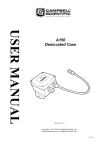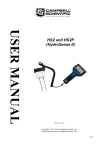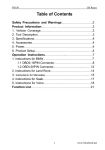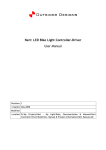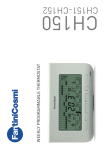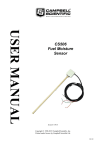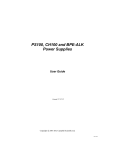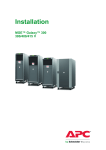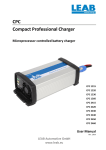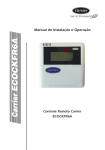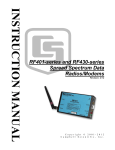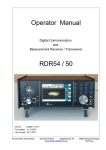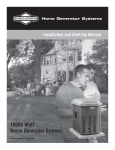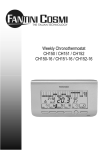Download PS150/CH150 12V Charging Regulators
Transcript
USER MANUAL PS150/CH150 12V Charging Regulators Issued: 15.10.14 Copyright © 2000-2014 Campbell Scientific, Inc. Printed under licence by Campbell Scientific Ltd. CSL 1041 Guarantee This equipment is guaranteed against defects in materials and workmanship. This guarantee applies for twelve months from date of delivery. We will repair or replace products which prove to be defective during the guarantee period provided they are returned to us prepaid. The guarantee will not apply to: Equipment which has been modified or altered in any way without the written permission of Campbell Scientific Batteries Any product which has been subjected to misuse, neglect, acts of God or damage in transit. Campbell Scientific will return guaranteed equipment by surface carrier prepaid. Campbell Scientific will not reimburse the claimant for costs incurred in removing and/or reinstalling equipment. This guarantee and the Company’s obligation thereunder is in lieu of all other guarantees, expressed or implied, including those of suitability and fitness for a particular purpose. Campbell Scientific is not liable for consequential damage. Please inform us before returning equipment and obtain a Repair Reference Number whether the repair is under guarantee or not. Please state the faults as clearly as possible, and if the product is out of the guarantee period it should be accompanied by a purchase order. Quotations for repairs can be given on request. It is the policy of Campbell Scientific to protect the health of its employees and provide a safe working environment, in support of this policy a “Declaration of Hazardous Material and Decontamination” form will be issued for completion. When returning equipment, the Repair Reference Number must be clearly marked on the outside of the package. Complete the “Declaration of Hazardous Material and Decontamination” form and ensure a completed copy is returned with your goods. Please note your Repair may not be processed if you do not include a copy of this form and Campbell Scientific Ltd reserves the right to return goods at the customers’ expense. Note that goods sent air freight are subject to Customs clearance fees which Campbell Scientific will charge to customers. In many cases, these charges are greater than the cost of the repair. Campbell Scientific Ltd, 80 Hathern Road, Shepshed, Loughborough, LE12 9GX, UK Tel: +44 (0) 1509 601141 Fax: +44 (0) 1509 601091 Email: [email protected] www.campbellsci.co.uk PLEASE READ FIRST About this manual Please note that this manual was originally produced by Campbell Scientific Inc. primarily for the North American market. Some spellings, weights and measures may reflect this origin. Some useful conversion factors: Area: 1 in2 (square inch) = 645 mm2 Length: Mass: 1 in. (inch) = 25.4 mm 1 ft (foot) = 304.8 mm 1 yard = 0.914 m 1 mile = 1.609 km 1 lb (pound weight) = 0.454 kg Pressure: 1 psi (lb/in2) = 68.95 mb Volume: 1 UK pint = 568.3 ml 1 UK gallon = 4.546 litres 1 US gallon = 3.785 litres 1 oz. (ounce) = 28.35 g In addition, while most of the information in the manual is correct for all countries, certain information is specific to the North American market and so may not be applicable to European users. Differences include the U.S standard external power supply details where some information (for example the AC transformer input voltage) will not be applicable for British/European use. Please note, however, that when a power supply adapter is ordered it will be suitable for use in your country. Reference to some radio transmitters, digital cell phones and aerials may also not be applicable according to your locality. Some brackets, shields and enclosure options, including wiring, are not sold as standard items in the European market; in some cases alternatives are offered. Details of the alternatives will be covered in separate manuals. Part numbers prefixed with a “#” symbol are special order parts for use with non-EU variants or for special installations. Please quote the full part number with the # when ordering. Recycling information At the end of this product’s life it should not be put in commercial or domestic refuse but sent for recycling. Any batteries contained within the product or used during the products life should be removed from the product and also be sent to an appropriate recycling facility. Campbell Scientific Ltd can advise on the recycling of the equipment and in some cases arrange collection and the correct disposal of it, although charges may apply for some items or territories. For further advice or support, please contact Campbell Scientific Ltd, or your local agent. Campbell Scientific Ltd, 80 Hathern Road, Shepshed, Loughborough, LE12 9GX, UK Tel: +44 (0) 1509 601141 Fax: +44 (0) 1509 601091 Email: [email protected] www.campbellsci.co.uk Precautions DANGER — MANY HAZARDS ARE ASSOCIATED WITH INSTALLING, USING, MAINTAINING, AND WORKING ON OR AROUND TRIPODS, TOWERS, AND ANY ATTACHMENTS TO TRIPODS AND TOWERS SUCH AS SENSORS, CROSSARMS, ENCLOSURES, ANTENNAS, ETC. FAILURE TO PROPERLY AND COMPLETELY ASSEMBLE, INSTALL, OPERATE, USE, AND MAINTAIN TRIPODS, TOWERS, AND ATTACHMENTS, AND FAILURE TO HEED WARNINGS, INCREASES THE RISK OF DEATH, ACCIDENT, SERIOUS INJURY, PROPERTY DAMAGE, AND PRODUCT FAILURE. TAKE ALL REASONABLE PRECAUTIONS TO AVOID THESE HAZARDS. CHECK WITH YOUR ORGANIZATION'S SAFETY COORDINATOR (OR POLICY) FOR PROCEDURES AND REQUIRED PROTECTIVE EQUIPMENT PRIOR TO PERFORMING ANY WORK. Use tripods, towers, and attachments to tripods and towers only for purposes for which they are designed. Do not exceed design limits. Be familiar and comply with all instructions provided in product manuals. Manuals are available at www.campbellsci.eu or by telephoning +44(0) 1509 828 888 (UK). You are responsible for conformance with governing codes and regulations, including safety regulations, and the integrity and location of structures or land to which towers, tripods, and any attachments are attached. Installation sites should be evaluated and approved by a qualified engineer. If questions or concerns arise regarding installation, use, or maintenance of tripods, towers, attachments, or electrical connections, consult with a licensed and qualified engineer or electrician. General • Prior to performing site or installation work, obtain required approvals and permits. Comply with all governing structure-height regulations, such as those of the FAA in the USA. • Use only qualified personnel for installation, use, and maintenance of tripods and towers, and any attachments to tripods and towers. The use of licensed and qualified contractors is highly recommended. • Read all applicable instructions carefully and understand procedures thoroughly before beginning work. • Wear a hardhat and eye protection, and take other appropriate safety precautions while working on or around tripods and towers. • Do not climb tripods or towers at any time, and prohibit climbing by other persons. Take reasonable precautions to secure tripod and tower sites from trespassers. • Use only manufacturer recommended parts, materials, and tools. Utility and Electrical • You can be killed or sustain serious bodily injury if the tripod, tower, or attachments you are installing, constructing, using, or maintaining, or a tool, stake, or anchor, come in contact with overhead or underground utility lines. • Maintain a distance of at least one-and-one-half times structure height, or 20 feet, or the distance required by applicable law, whichever is greater, between overhead utility lines and the structure (tripod, tower, attachments, or tools). • Prior to performing site or installation work, inform all utility companies and have all underground utilities marked. • Comply with all electrical codes. Electrical equipment and related grounding devices should be installed by a licensed and qualified electrician. Elevated Work and Weather • Exercise extreme caution when performing elevated work. • Use appropriate equipment and safety practices. • During installation and maintenance, keep tower and tripod sites clear of un-trained or non-essential personnel. Take precautions to prevent elevated tools and objects from dropping. • Do not perform any work in inclement weather, including wind, rain, snow, lightning, etc. Maintenance • Periodically (at least yearly) check for wear and damage, including corrosion, stress cracks, frayed cables, loose cable clamps, cable tightness, etc. and take necessary corrective actions. • Periodically (at least yearly) check electrical ground connections. WHILE EVERY ATTEMPT IS MADE TO EMBODY THE HIGHEST DEGREE OF SAFETY IN ALL CAMPBELL SCIENTIFIC PRODUCTS, THE CUSTOMER ASSUMES ALL RISK FROM ANY INJURY RESULTING FROM IMPROPER INSTALLATION, USE, OR MAINTENANCE OF TRIPODS, TOWERS, OR ATTACHMENTS TO TRIPODS AND TOWERS SUCH AS SENSORS, CROSSARMS, ENCLOSURES, ANTENNAS, ETC. Contents PDF viewers: These page numbers refer to the printed version of this document. Use the PDF reader bookmarks tab for links to specific sections. 1. Introduction ................................................................ 1 2. Precautions and Tips................................................. 2 3. Quick Start ................................................................. 3 3.1 3.2 3.3 3.4 3.5 3.6 Connecting Power ................................................................................ 4 3.1.1 Solar Panel .................................................................................... 5 3.1.2 AC/DC Power ............................................................................... 5 Plug In the Battery ............................................................................... 6 Hook Up Power to Datalogger ............................................................. 8 Turn On the Charging Source .............................................................. 8 Turn On Power to the Datalogger ........................................................ 8 LED Indicator ...................................................................................... 8 4. Specifications ............................................................ 9 4.1 4.2 4.3 Specifications ....................................................................................... 9 Battery Packs ..................................................................................... 10 Charging Sources ............................................................................... 10 5. Operational Overview .............................................. 11 6. Charging Details ...................................................... 12 6.1 6.2 Charging Algorithm ........................................................................... 12 Maximum Power Point Tracking ....................................................... 12 7. A100 Null Modem Adapter....................................... 13 8. A105 Additional 12 V Terminals Adapter ............... 14 9. References ............................................................... 14 Figures 3-1. 3-2. 3-3. 3-4. 3-5. 3-6. 3-7. 3-8. 6-1. 7-1. 7-2. 8-1. The PS150 connected to a CR1000 and AC power .............................. 3 The PS150 connected to a CR1000 and solar panel ............................. 4 CH150 connected to BP24 battery pack and CR1000 ......................... 4 Solar panel connections on PS150 ....................................................... 5 AC power connections on PS150 ......................................................... 6 Lift latch up on PS150 ......................................................................... 7 Slide PS150 lid off ............................................................................... 7 Wiring harness plugged into battery connector .................................... 8 70 W solar panel I – V and power characteristics .............................. 13 Null modem connections ................................................................... 13 PS150 with A100 module using a COM220 and RF450 ................... 14 A105 adapter ...................................................................................... 14 i ii PS150/CH150 12V Charging Regulators 1. Introduction The PS150 is a 12 Vdc power supply that includes a rechargeable 7 Ah valveregulated lead-acid (VRLA) battery and charging regulator. The CH150 is a charging regulator for an external rechargeable 12 V VRLA battery such as the BP12 or BP24 offered by Campbell Scientific. Charging power for these charging regulators is typically supplied by an unregulated solar panel, AC/AC transformer, or AC/DC converter. The PS150/CH150 are smart chargers that provide charging with temperature compensation for optimal charging and battery life. A maximum power point tracking algorithm is incorporated for solar inputs to maximize available solar charging resources. The PS150/CH150 are compatible with the A100 null-modem adapter and the A105 adapter for additional 12 V output terminals. The A100 Null Modem Adapter connects and powers two Campbell Scientific peripherals via two CS I/O 9-pin connectors configured as a null modem. This is useful in linking different communications technologies; e.g., telephone to radio, at sites that do not have a datalogger. The A105 adapter may be used to provide additional 12 V and ground terminals where the power supply is used to power several devices. The PS150/CH150 charging regulators are termed series regulators, because the regulators are placed in series between the charging source and the load. As batteries become closer to fully charged, series regulators reduce the current drawn from the charging source, to where the charging source may be completely unloaded if full-charge is reached. While this unloading of the charging source is acceptable for solar panels, AC/AC transformers and AC/DC converters, it is undesirable for wind turbines because of the resulting free spinning when unloaded. Consequently, series charging regulators, including the PS150/CH150, should not be used to regulate the output of wind turbines without the inclusion of a way to load the turbine when the batteries require little or no charging current. The PS150/CH150 chargers have several safety features intended to protect the charging source, battery, charger, and load devices. Both the SOLAR – G and CHARGE – CHARGE input terminals incorporate hardware current limits and polarity reversal protection. There is a 5 A fuse in series with the CHARGE – CHARGE inputs in the event of a catastrophic AC/AC or AC/DC charging source failure. There is a 4.7 A solid-state breaker in series with the 12 V output terminals of the charger in the event of an output load fault. The PS150/CH150 incorporate battery reversal protection, which is catastrophic for most chargers. ESD and surge protection are incorporated on all inputs and outputs of the PS150/CH150. 1 PS150/CH150 12V Charging Regulators 2. Precautions and Tips CAUTION For indoor use only. WARNING Risk of electric shock. Dry location use only. WARNING Risk of fire or electric shock. Do not interconnect output terminals. WARNING Permanent damage to rechargeable cells may result if discharged below 10.5 V. Under normal charging conditions with sealed VRLA batteries, hydrogen and oxygen gasses are produced in relatively small quantities, most of which later recombines back into water. Aggressive overcharging produces excess hydrogen and oxygen gasses, resulting in gas venting by means of a pressure activated valve. Hydrogen gas emitted from VRLA batteries must not be allowed to accumulate, as it could form an explosive mixture. Fortunately, hydrogen gas is difficult to contain in anything but a metal or glass enclosure. WARNING Never put VRLA batteries in an enclosure that does not allow emitted hydrogen gas to be dispersed. VRLA batteries are capable of providing high surge currents. The 12 V output terminals of the PS150/CH150 are fused with a 4 A self-resettable thermal fuse, but there is no fusing for inadvertent bridging of the battery terminals. Accidental shorting of battery terminals by metallic objects, such as watchbands, can cause severe burns due to rapid heating and is also a fire hazard. VRLA battery manufacturers state that “Heat Kills Batteries”. While the PS150/CH150 can operate from –40° to +60°C, optimum battery life is achieved with battery operating temperatures ranging from 5° to 35°Ci, per manufacturer’s recommendations1. The PS150/CH150 offer temperature compensation of the battery charging voltage based on a temperature measurement inside the PS150/CH150 cases. The CH150 internal temperature measurement likely will not accurately represent battery temperature for charge voltage compensation unless the battery is in close proximity to the CH150. With rechargeable batteries, a charge discharge re-charge event is termed a cycle. In general the most important factor for the service life of a battery is depth of discharge1. For example, decreasing the depth of each discharge from 100% to 50% approximately doubles the number of useful cycles available from the battery1. CAUTION Leaving a lead-acid battery in a discharged state for prolonged periods of time results in the undesirable growth of large sulphate crystals (sulphating) that are detrimental to battery performance. i Genesis Application Manual – Genesis NP and NPX Series US-NP-AM-002, June 2006. 2 User Manual VRLA batteries self-discharge at approximately 3% of rated capacity per month at room temperature1. A 3% of rated capacity per month self-discharge results in 100% discharge in approximately 33 months ( 3 years) for a battery stored at room temperature. Self-discharge increasing with increasing storage temperature. NOTE 3. Periodic recharging of stored batteries every few months is recommended to prevent irreversible sulphation due to prolonged time in a discharged state. Quick Start The PS150/CH150 modules are designed to handle extreme conditions. The modules have been designed with mounting holes on one inch centres for mounting to a standard Campbell Scientific enclosure back plate — see the enclosure manual for mounting suggestions. See Figure 3-1 through Figure 3-3 for typical enclosure installations using a PS150/CH150. Figure 3-1. The PS150 connected to a CR1000 and AC power 3 PS150/CH150 12V Charging Regulators Figure 3-2. The PS150 connected to a CR1000 and solar panel Figure 3-3. CH150 connected to BP24 battery pack and CR1000 3.1 Connecting Power WARNING 4 Although the power supply and battery are low voltage, they do have the ability to supply a high current and could potentially heat up a metal ring, watch band, or bracelet enough to burn skin or melt metal when shorted. Remove rings, watches, or bracelets before hooking up power and connecting a battery. User Manual Unlike earlier Campbell Scientific power supplies, the CH/PS150 can have both solar and AC power hooked up simultaneously. Flip the power supply switch to “Off” before hooking up power to the power supply. NOTE The switch on the CH/PS150 only controls power going to the “12V” and “G” terminal blocks. The battery is continuously charged regardless of the switch setting as long as a charging voltage is present. 3.1.1 Solar Panel WARNING To prevent sparking while wiring up the solar panel, either lay the solar panel face down on its packing box or cover it with something fairly opaque to block the sunlight while wiring up the panel. Connect the black (negative) lead from the solar panel to the terminal block marked “G” that is directly adjacent to the “SOLAR” terminal block. Connect the red (positive) lead from an unregulated solar panel to the terminal block marked “SOLAR”. See Figure 3-4. Figure 3-4. Solar panel connections on PS150 3.1.2 AC/DC Power Double check the input voltages coming in to the charger/regulator with a volt meter. AC Input Voltage: 14 to 24 VAC RMS DC Input Voltage: 15 to 40 VDC WARNING Exceeding the voltages listed above will damage the power supply. Disconnect the primary side of the AC/DC power before connecting wires to the PS150. 5 PS150/CH150 12V Charging Regulators Connect the secondary power supply leads to the two terminal blocks marked “CHG”. There is no polarity on the “CHG” terminal blocks, so it does not matter which wire goes to which “CHG” terminal block, but make sure there is only ONE wire per block. See Figure 3-5. Figure 3-5. AC power connections on PS150 3.2 Plug In the Battery The battery used with the PS150 is shipped inside of the PS150 case if the power supply is NOT installed inside an enclosure. If the PS150 is mounted inside an enclosure then the battery will be located separately packed in one of the packing boxes. This is done to minimize any damage that could occur if the power supply should get loose from its mounts inside the enclosure during shipment. The battery will NOT be plugged into the PS150. This is done to minimize discharging the battery. To remove the lid from the PS150, pull up on the PS150 lid latch and slide the lid off as shown in Figure 3-6 and Figure 3-7. WARNING 6 Do not remove the tape holding the battery wiring harness to the top of the battery! The tape is used to keep the battery wiring harness out of the way of the rubber bumpers on the inside of the lid. User Manual Latch Lift latch up. Figure 3-6. Lift latch up on PS150 Slide lid off. Figure 3-7. Slide PS150 lid off Plug the battery into the connector marked “BATT”. This connector is polarized and will only allow the mating connector to be plugged in one way. Push the connector all the way in until it locks in place. 7 PS150/CH150 12V Charging Regulators Figure 3-8. Wiring harness plugged into battery connector 3.3 Hook Up Power to Datalogger Both the PS150 and the CH150 come with a 1 foot black wire attached to one of the G terminal blocks and a 1 foot red wire attached to one of the 12V terminal blocks. Attach the red wire from the power supply to the datalogger Power terminal block marked 12V (Campbell Scientific part number 3768). Attach the black wire from the power supply to the datalogger Power terminal block marked “G”. 3.4 Turn On the Charging Source Turn on the power going to the charging source or uncover the solar panel. The green “Charge” LED will flash approximately once a second if all incoming connections are correct and there is an adequate charging voltage present. 3.5 Turn On Power to the Datalogger Flip the switch on the PS150/CH150 supply to “On”. Verify voltage to the datalogger with a volt meter, or use a key pad display, or connect to the datalogger with a laptop or PDA to make sure the datalogger is running correctly. 3.6 LED Indicator The green “Charge” LED will flash approximately once a second if all incoming connections are correct and there is an adequate charging voltage present. 8 User Manual 4. Specifications 4.1 Specifications (CHARGE - CHARGE terminals) AC or DC Source: AC – (18 to 24) VRMS internally limited to 1.2 ARMS DC – (16 to 40) Vdc internally limited to 0.85 A DC (SOLAR terminals) Solar Panel or Other DC Source1: 15 to 40 Vdc Maximum Charging Current: 4.0 ADC typical 3.2 ADC to 4.8 ADC depending on individual DC voltage source Battery Charging FLOAT Charging: Vbatt(T) = 13.65 – (24 mV)•(T – 25) + (0.24 mV)•(T – 25)2 1% Accuracy on charging voltage over –40° to +60C range Operational Temperature Range2: –40° to +60C Power Out (+12 terminals) Voltage: Unregulated 12 V from Battery 4.65 A solid-state circuit breaker Quiescent Current No Charge Source Present: 160 A at 13.7 Vdc No Battery Connected: 930 A at 30 volt input voltage (ac or dc) Rated UL Class 2 Power Supply Physical Specifications PS150: 10.6 cm (4.2 in) tall, 19.3 cm (7.5 in) long, 7.6 cm (3 in) wide CH150: 10.0 cm (3.9 in) tall, 7.5 cm (3 in) long, 3.7 cm (1.5 in) wide 1. Battery voltages below 8.7 V may result in < 3.0 A current limit because of foldback current limit. 2. VRLA battery manufacturers state that “heat kills batteries” and recommend operating batteries 50C. 9 PS150/CH150 12V Charging Regulators 4.2 Battery Packs Battery Pack Model Amp-Hour Capacity (Ah) *Operating Temperature Range (ºC) PS150 7 Charge: –15 to +50 Discharge: –20 to +60 EnerSys/Genesis/YUASA BP12 12 Charge: –15 to +50 Discharge: -20 to +60 EnerSys/Genesis/YUASA BP24 24 Charge: –15 to +50 Discharge: –20 to +60 EnerSys/Genesis/YUASA Battery Family * Battery specifications shown are from the manufacturer. The PS150/CH150 contains charging algorithms that optimize battery charging over the range of –40°C to +50°C. Battery usage outside of manufacturer specifications could have unknown effects on the life of the battery. WARNING 4.3 Battery life is shortened if the battery is allowed to discharge below 11.5 V. Charging Sources SP5 SP10 SP30 SP60 SP100 Peak Power 4.5 W 10 W 30 W 60 W 100 W Voltage @ Peak Power 16.5 V 16.8 V 17.5 V 17.5 V 18.0 V Current @ Peak Power 0.27 A 0.57 A 1.68 A 3.43 A 5.56 V Notes: 10 1. Specifications assume a 1 kilowatt per square metre illumination and a solar panel temperature of 25C (77F). 2. Individual panels may vary up to 10%. 3. The output panel voltage increases as the panel temperature decreases, which is in the same direction as the recommended VRLA battery charging voltage change with temperature. 4. Higher latitudes and less sun hours during winter months might require a larger panel than what is required to keep the battery charged during the summer. User Manual AC/DC Transformer with Interchangeable Blades: Campbell Scientific Model No. 29796-UK Input Voltage: 100 – 240 Vac Input Frequency: 47 – 63 Hz Output Voltage: 24 Vdc Output Current (max): 1.67 A Protection: Unit will auto-recover upon removal of fault. UL Approval: UL60950-1 2nd Edition Unit has interchangeable blades. Unit ships with UK/CEEE plug. NOTE The recommended chargers have dc voltage output which can be used on either the CHARGE/CHARGE or SOLAR/G terminal blocks. Maximum input charging current on the CHARGE/CHARGE terminal blocks is limited to 1.1 Adc. Maximum input charging current on the SOLAR/G terminal blocks is limited to 3.6 Adc. CHARGE/CHARGE terminal blocks have no polarity. Power wires from the charging source can be connected in any fashion. The PS150/CH150 will only float charge a battery with power connected to the CHARGE/CHARGE terminal blocks which is fine when using an AC/DC charging source. SOLAR/G terminal blocks do have a polarity that must be followed when wiring up either of the AC/DC devices. Positive wire goes to the terminal block marked SOLAR. Negative wire goes to the terminal block marked G. Higher power throughput makes this an attractive option. It will float charge a battery but it will also try to quick charge as well depending on the needs of the battery. 5. Operational Overview A 12-V 7Amp-hr rechargeable battery is included with the PS150, whereas the user provides the rechargeable battery, such as the BP12 or BP24 offered by Campbell Scientific, Ltd., for the CH150. See Section 0, Battery Packs, for rechargeable batteries offered for the CH150 by Campbell Scientific. Charging power for the PS150/CH150 is typically supplied by an unregulated solar panel, AC/AC transformer, or AC/DC converter. The CHARGE – CHARGE terminals are connected to a diode bridge, accommodating either AC or DC voltages from a charge source. Because of the diode bridge, polarity does not matter when connecting sources to the CHARGE – CHARGE input terminals. In order to protect AC/AC or AC/DC sources when charging discharged batteries, the CHARGE – CHARGE input terminals offer an approximately 1.1 amps DC (1.2 A RMS) current limit. The SOLAR – G input terminals are intended for connection to solar panels, or other high-current DC sources. Polarity definitely matters on the DC only SOLAR – G input terminals, with positive connected to SOLAR and the return or negative connected to G, with reversal protection included. The SOLAR – G input terminals have an input current limit of approximately 3.6 amps, making the PS150/CH150 well suited for 70 watt or smaller solar panels. The PS150/CH150 can be simultaneously powered from both the CHARGE – CHARGE and SOLAR – G input terminals, as the internal diodes will route power from the source with the highest input voltage. This allows for an AC mains powered application with a solar panel for back-up. If the reverse is needed – solar power as the primary supply and AC as the secondary 11 PS150/CH150 12V Charging Regulators supply – then a solar panel should be used with a 24 Vdc output and an AC, or AC to DC, source with a voltage output less than the solar panel voltage. An AC/DC converter charge source could be connected to either the CHARGE – CHARGE input terminals or the SOLAR - G input terminals. The best input terminals to use with a given AC/DC converter should be based on the converters output current capability. For example, the CHARGE – CHARGE input terminals provide a current limit of 1.1 A DC on the charging source. Whereas the SOLAR - G input terminals have a fixed 3.6 A DC typical current limit, providing faster battery charging for a charge source that can deliver up to 3.6 A DC current without damage. The SOLAR – G terminals are optimal for solar panels because of the high-current charging capability when solar resources are available. A Maximum Power Point Tracking algorithm is also utilized when the PS150/CH150 detects the charging source is connected to the SOLAR input. The +12 V output terminals are intended to power a datalogger and any peripherals. Power to these output terminals is controlled by a toggle switch, with the total output current limited by a 4.65 A solid-state circuit breaker (see Section 4.1, Specifications). The A105 Additional 12 V Terminals Adapter may be used to provide extra 12 V and ground terminals where the power supply is used to power several devices, noting that the hold current limit on the 4.65 A solid-state circuit breaker still applies. 6. Charging Details 6.1 Charging Algorithm The PS150/CH150 offers both Continuous and Solar charging inputs. The Continuous charging input has a maximum value of 1.1 A DC to help protect AC/AC transformers and AC/DC converters. The 3.6 ADC typical current limit of the PS150/CH150 Solar charging input is well suited for 70 W solar panels. Typical Continuous charging inputs would be AC/AC transformers or AC/DC converters in which a charge voltage is continuously applied except for line power outages. The PS150/CH150 uses a float charging algorithm for either the Continuous or Solar charging inputs. This charging method can charge a battery indefinitely without overcharging a battery. 6.2 Maximum Power Point Tracking The current and power versus voltage for a 70 W solar panel are illustrated in Figure 6-1. As can be seen from the figure, a Maximum Power Point of operation exists for solar panels. Adjusting the load on the solar panel so it operates at this Maximum Power Point is referred to as Maximum Power Point Tracking (MPPT). MPPT is beneficial when insufficient power is available from the charge source, which is the case during current limited charging. The somewhat noisy charging current and voltage during the initial current limited charging stage is due to the MPPT algorithm of the PS150/CH150 searching for the maximum power point of the associated solar panel. 12 User Manual 4.5 70 4.5 70 60 50 2.7 40 Im Pm 30 1.8 Power (Watts) Current (Amps) 3.6 20 0.9 10 0 0 0 0 0 1 2 3 4 5 6 7 8 0 9 10 11 12 13 14 15 16 17 18 19 20 21 Vcm 21 Voltage (Volts) Figure 6-1. 70 W solar panel I – V and power characteristics 7. A100 Null Modem Adapter The A100 adapter has two 9-pin CS I/O ports with a null modem between them. The ports are used to connect two 9-pin devices (e.g., modems or RF radios) that would normally be connected to the CS I/O port of a Campbell datalogger. The charger supplies 12 Vdc and 5 Vdc to the appropriate pins on the connector for powering the connected devices. This functionality is required in a station where a datalogger will not be present, such as a phone-to-RF base station. The A100 cannot be used as a null modem between two RS-232 devices. Figure 7-1. Null modem connections 13 PS150/CH150 12V Charging Regulators Figure 7-2. PS150 with A100 module using a COM220 and RF450 8. A105 Additional 12 V Terminals Adapter The A105 adapter adds four 12 V terminals and four ground terminals to a PS150/CH150 charging regulator. The extra terminals make it easier to wire multiple continuously powered 12 Vdc devices to the power supply. Figure 8-1. A105 adapter 9. References 1 – Genesis Application Manual – Genesis NP and NPX Series US-NP-AM-002, June 2006. 14 User Manual 15 CAMPBELL SCIENTIFIC COMPANIES Campbell Scientific, Inc. (CSI) 815 West 1800 North Logan, Utah 84321 UNITED STATES www.campbellsci.com [email protected] Campbell Scientific Africa Pty. Ltd. (CSAf) PO Box 2450 Somerset West 7129 SOUTH AFRICA www.csafrica.co.za [email protected] Campbell Scientific Australia Pty. Ltd. (CSA) PO Box 8108 Garbutt Post Shop QLD 4814 AUSTRALIA www.campbellsci.com.au [email protected] Campbell Scientific do Brazil Ltda. (CSB) Rua Apinagés, nbr. 2018 - Perdizes CEP: 01258-00 São Paulo SP BRAZIL www.campbellsci.com.br [email protected] Campbell Scientific Canada Corp. (CSC) 14532 – 131 Avenue NW Edmonton, Alberta T5L 4X4 CANADA www.campbellsci.ca [email protected] Campbell Scientific Centro Caribe S.A. (CSCC) 300N Cementerio, Edificio Breller Santo Domingo, Heredia 40305 COSTA RICA www.campbellsci.cc [email protected] Campbell Scientific Ltd. (CSL) 80 Hathern Road, Shepshed, Loughborough LE12 9GX UNITED KINGDOM www.campbellsci.co.uk [email protected] Campbell Scientific Ltd. (France) 3 Avenue de la Division Leclerc 92160 ANTONY FRANCE www.campbellsci.fr [email protected] Campbell Scientific Spain, S. L. Avda. Pompeu Fabra 7-9 Local 1 - 08024 BARCELONA SPAIN www.campbellsci.es [email protected] Campbell Scientific Ltd. (Germany) Fahrenheitstrasse13, D-28359 Bremen GERMANY www.campbellsci.de [email protected] Campbell Scientific (Beijing) Co., Ltd. 8B16, Floor 8 Tower B, Hanwei Plaza 7 Guanghua Road, Chaoyang, Beijing 100004 P.R. CHINA www.campbellsci.com [email protected] Please visit www.campbellsci.com to obtain contact information for your local US or International representative.


























